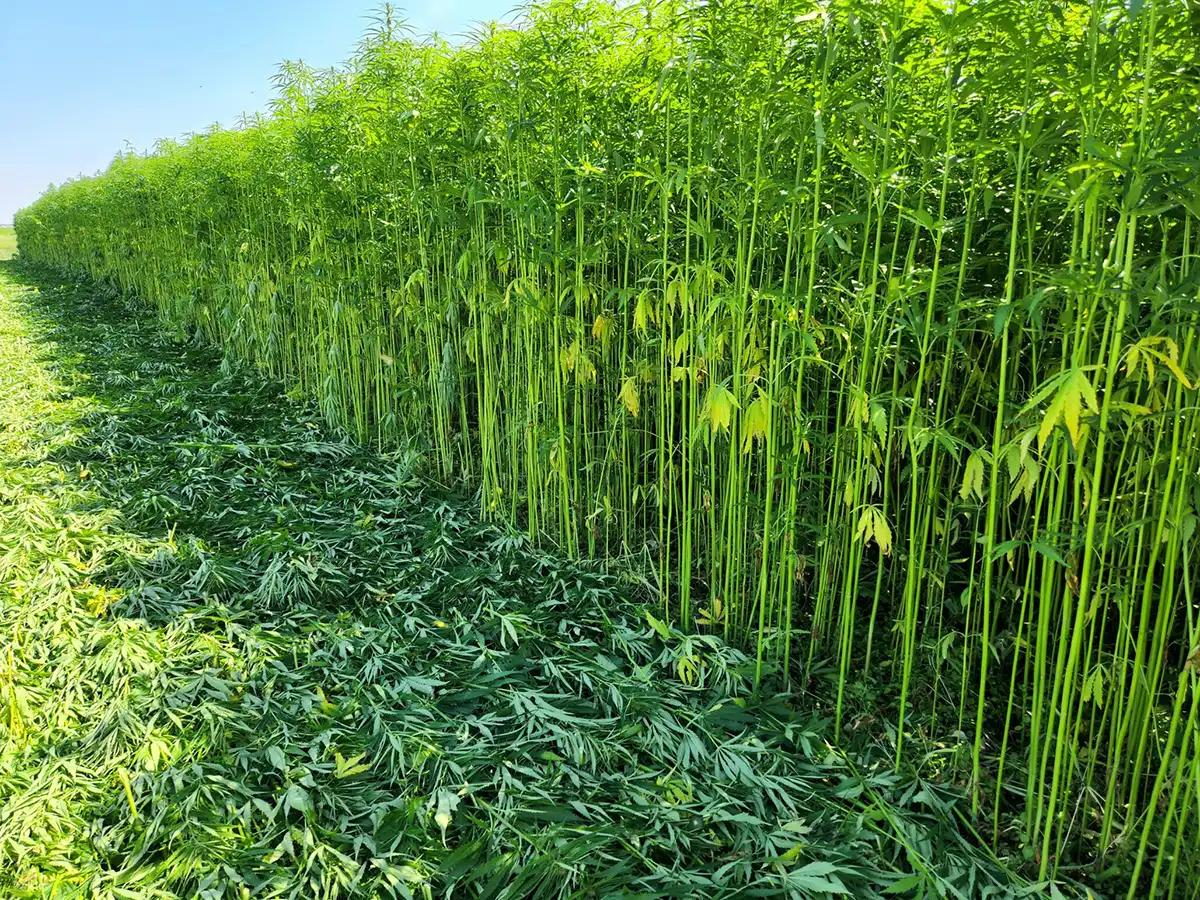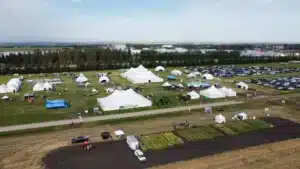Results from the hemp variety trials are meant to help expand the hemp fibre industry across Canada.
Hemp has been grown in Alberta since the 1990s when the crop was first legalized for production. In that time, the acreage has increased but the crop has been held back due to lack of research into fibre processing.
Growing hemp for fibre has had limited opportunities in Canada for many years. Despite Alberta emerging as one of the largest producers of hemp in Canada for the last decade, the primary focus has been on grain production. Farmers growing hemp for grain combine the hemp seed and leave hemp bales in their fields due to a lack of buyers. The limiting factor in the fibre market has been lack of processing (decortication) facilities for processing the straw, which is the key to completing the hemp fibre supply chain.
In 2022, Canadian Rockies Hemp Corp. (CRHC) and Alberta hemp producers decided to focus on identifying hemp fibre varieties suitable for growing in Alberta. This was necessary to grow the industry and increase revenues for Alberta farmers. Prior to CRHC’s Bruderheim Decortication Facility in Bruderheim, Alta., there were no decortication capacity in Canada and, as a result, there were limited fibre varieties available for farmers.
Not only were fibre varieties of hemp not commercially available to producers, but they were also being phased out because farmers growing hemp for grain had issues with fibre wrapping around combine headers The industry recognized that in order to expand hemp fiber as a broad acre rotational crop in the province, there was a need for both experienced agronomy knowledge and specialized fiber varieties.
Hemp Variety Trial Project
To allow farmers the option to grow hemp for fibre, research was required on the best hemp varieties suited for fibre production through a variety trial project. The value-added research project was meant to identify hemp varieties to add to Health Canada’s List of Approved Cultivars. It was led by CRHC in collaboration with the University of Alberta, Canadian Hemp Trade Alliance (CHTA), Alberta Hemp Alliance (AHA) and Alberta Agriculture and Irrigation. The total cost of the project was more than $1.5 million.
“The project evaluated multiple types, as well as new varieties to Canada, in order to evaluate which varieties had the best field and processing results,” Clinton Dobson, executive director of research at Results Driven Agriculture Research (RDAR), states in an email. RDAR provided funding support the variety trials.
“The project has now been completed with the results contributing to the addition of new high-performing fibre varieties to Health Canada’s List of Approved Cultivators and research-based evidence showing which varieties are better for fibre production in Alberta,” says Dobson.
Not only did this research project provide support for farmers on whether to include hemp in their crop rotations, Dobson adds “the data generated has expanded the knowledge pertaining to seeding, fertilizing, harvesting, and processing hemp fibre.”
Research areas and priorities included enhanced productivity, profitability, and competitiveness; extension and knowledge transfer; market demands including quality, value-added products, and diversification; and sustainable and responsible agricultural production.
Fostering Sustainable Hemp Production Through Fibre Processing
Growing hemp for fibre production isn’t just about providing farmers with more monetary options for hemp, but also allowing for sustainable hemp production. In an interview, CRHC notes they’re committed to fostering sustainable hemp fibre processing and optimizing the efficient and regenerative use of agricultural land. As part of the regional variety trial program, the organization also undertook a comprehensive evaluation of hemp fibre cultivation in Alberta.
“We assessed the performance of traditional Canadian dual-purpose hemp varieties alongside innovative ‘fibre dominant’ strains developed in Canada and three specialty Ukrainian-bred varieties,” Aaron Barr, CRHC CEO, explains in an email. “These evaluations took place across expansive trial plots spanning diverse soil types in north, central, and eastern Alberta, covering a substantial land area totaling approximately 6,000 acres across more than 40 fields.”
The trials focused exclusively on dryland cultivation as it’s economically unfeasible to use irrigated fields for fibre production. The study encompassed a range of critical stages including spring soil analysis, fertility assessments and recommendations, seeding guidance, in-crop management, post-harvest soil analysis, and detailed assessments of harvesting and decortication processes.
“CRHC took responsibility for all harvest-related activities, including cutting, tedding, raking, and baling, with the resulting bales transported to our processing facility located in Bruderheim for decortication,” adds Barr.
CRHC aren’t the only ones working to grow the Alberta hemp industry. AHA is also focused on helping to create a strong, competitive, and diversified hemp industry in the province.
“Hemp offers producers an opportunity to capitalize on diversification with a high-value crop alternative,” Russ Crawford, an AHA member and past president of CHTA, says in an email. “It is a superior crop with respect to the environmental impact of farming and hemp fibre production provides a significant opportunity to generate carbon offsets for Alberta’s oil and gas industry. Virtually all hemp produced in Alberta is processed before export. The AHA is charged with the goal of seeing that processing happen here in Alberta.”

Hemp Production for the Future
This may seem like a lot of work for what has traditionally been a crop planted on marginal acres. Statistics Canada reported 55,400 acres of industrial hemp were planted in 2023, with 20,000 acres seeded in Alberta. This is down from 76,900 acres nationally in 2022. According to Crawford, hemp is described as a niche crop due to its small acreage and limited market opportunities, adding the 60-year hemp prohibition was primarily to blame for this marginalization.
“The recent removal of that prohibition has opened the door for hemp, but it has a lot of catching up to do. In our view, if hemp had been on a level playing field with canola in the early 1970s, it is very likely hemp acreage today would equal or even exceed canola acreage. It isn’t a big enough crop today by all measures, but it has the potential to be a game changer for Canadian agriculture.”
Barr adds hemp is emerging as a vital crop with significant implications for both Alberta’s agricultural sector and its economy. Alberta has accounted for almost half of Canada’s hemp production.
“Although the total acreage devoted to hemp cultivation in Alberta may currently appear modest compared to other crops, several factors contribute to this scenario,” he says. These factors include the novelty of it as a crop, limited availability of commercial processors for hemp feedstock, specialized equipment is required for harvesting of fibre production hemp and lacking knowledge about hemp cultivation.
“However, the landscape is evolving rapidly,” Barr says. “Increasing consumer demand for sustainable inputs is creating a growing market for products produced from hemp. Moreover, farmers are seeking profitable crop alternatives to diversify their rotations and combat issues like clubroot disease, and hemp is emerging as a promising choice for them.”
Additionally, the cultivation of hemp supports the regenerative use of agricultural land and contributes to sequestering large volumes of carbon in both the soil and biomass.
There are numerous benefits of the variety trials. For example, Dobson says the biggest advantage is that farmers and processors are pursuing and leading the development of Canada’s hemp fibre industry.
“The research analyzed the production capabilities and characteristics of new varieties in Alberta (and Canada with) new varieties available globally that are being tested in Alberta. RDAR’s investment is in support of farmers and the hemp fibre industry identifying the varieties that are best suited agronomically and towards the manufacturing use of the hemp fibre,” Dobson explains.
He adds varieties that work well in the food industry may not function well for fibre processing. There also may be different fibre varieties best suited for the different types of fibre markets.
Barr says the outcome of the CRHC project has yielded information into what the most promising hemp fibre varieties are, optimal soil types for growing, fertility requirements, seeding methods, harvesting techniques, and decortication processes.
“The significance of this research cannot be overstated, as it is pivotal for the growth of the Canadian hemp fibre industry,” Barr says. “The development of high-yield hemp fibre varieties promises to boost revenues for Alberta’s farming community, ultimately contributing to the expansion and success of the hemp sector.”
He adds that due to this research, several high-performing fibre varieties will be added to the List of Approved Cultivars and three Ukrainian varieties, Hlesiia, Hlukhivs’ki 85 and Hlukivs’ki 51, have been approved by the Canadian Seed Growers’ Association and have been submitted for inclusion on Health Canada’s List of Approved Cultivars.
“Furthermore, the project has provided concrete research-based evidence guiding the selection of Canadian hemp varieties that are particularly well-suited for fibre production in the Prairies, enhancing the industry’s sustainability and competitiveness,” Barr adds.
Investor Opportunities for Hemp Processing
In 2022, INCA, a global hemp manufacturer, announced a $72-million hemp processing facility in Vegreville, Alta. while Blue Sky Hemp Ventures has announced plans for a $75-million hemp food processing facility. Smoky Hemp Decortication Ltd. has broken ground in Donnelly, Alta. with plans to expand acreage in the southern Peace region.
As processing facilities are built and increase their operating capacity, more opportunities will become available for farmers to grow hemp for fibre. Dobson says emerging business investment and market opportunities are working to create a $1 billion market in Canada for hemp.
CHTA is also conducting research to support the registration of hemp products as livestock feed. The research is focused on showing the safety of the products. This will allow for there to be a use for hemp grain which is a by-product of the fibre manufacturing process.
“Alberta’s hemp industry is in the early stages of emerging and its success will be based on the investment attraction of processing capacity,” adds Dobson. “Ensuring a strong knowledge base will guide production decisions and the long-term success in the emerging market.”













